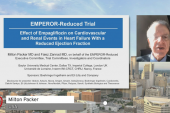Empagliflozin Succeeds in HFpEF: EMPEROR-Preserved Top-line Results
The trial met its primary endpoint showing the SGLT2 inhibitor cuts CV death/hospitalization in this hard-to-treat subset.

The EMPEROR-Preserved trial of empagliflozin (Jardiance; Boehringer Ingelheim/Eli Lilly) met its primary endpoint, according to top-line results released today, meaning a therapy with specific benefits in patients with heart failure and preserved ejection fraction (HFpEF) may finally be on its way.
Compared with placebo, empagliflozin reduced the risk of a composite of CV death or hospitalization for heart failure in adults with HFpEF, regardless of diabetes status, making the sodium-glucose cotransporter 2 (SGLT2) inhibitor “the first and only therapy” to meet that mark, the drugmakers announced Tuesday. Empagliflozin’s safety profile was “generally consistent” with what’s known about the medication, they added.
Full results will be presented at the end of August during the virtual European Society of Cardiology Congress.
Empagliflozin was previously shown to improve hard clinical outcomes in patients with heart failure and reduced ejection fraction (HFrEF) in the EMPEROR-Reduced trial. If regulators grant approval based on the findings of both the HFrEF and HFpEF trials, empagliflozin “would become the first and only clinically proven therapy to improve outcomes for the full spectrum of heart failure patients regardless of ejection fraction,” Boehringer Ingelheim and Eli Lilly said.
It has already been approved in Europe for the treatment of HFrEF, but awaits a heart failure indication in the United States.
Of note, the US Food and Drug Administration previously granted empagliflozin Fast Track status for the treatment of chronic heart failure, “a process designed to facilitate the development, and expedite the review, of drugs to treat serious conditions and fill an unmet medical need.”
The SGLT2 inhibitors were developed for the treatment of type 2 diabetes, but apparent heart failure benefits in the initial trials led to the design of trials specifically testing the agents in patients with heart failure with or without diabetes.
Empagliflozin was the not the first SGLT2 inhibitor to demonstrate a clinical benefit for patients with heart failure: dapagliflozin (Farxiga; AstraZeneca) reduced hard outcomes in a HFrEF population in the DAPA-HF trial. Whether dapagliflozin will benefit patients with HFpEF awaits the results of the ongoing DELIVER trial.
Other therapies hold promise for the treatment of HFpEF as well. Sotagliflozin, an investigational inhibitor of both SGLT 1 and 2, lowered CV mortality and hospitalizations/urgent visits for heart failure across patients with a range of ejection fractions in the SOLOIST-WHF and SCORED trials, which included a mix of patients with acute heart failure and those with diabetes, chronic kidney disease, and at least one major CV risk factor.
In addition, the FDA earlier this year modified the indication for sacubitril/valsartan (Entresto) in a way that would allow for use of the angiotensin receptor-neprilysin inhibitor in at least some patients with HFpEF.
Todd Neale is the Associate News Editor for TCTMD and a Senior Medical Journalist. He got his start in journalism at …
Read Full BioSources
Eli Lilly. Breakthrough results for Jardiance (empagliflozin) confirm EMPEROR-Preserved as first and only successful trial for heart failure with preserved ejection fraction. Published and accessed on: July 6, 2021.




Comments